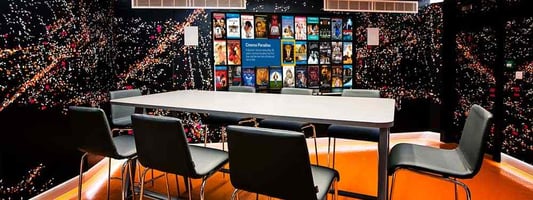Leading workplace consultant, Saracen Interiors has completed work at the new UK address for...
How To Create Healthy Workplace Lighting
It is widely accepted that good office design is directly linked with employee happiness and productivity. However, there is also a proven correlation between good workplace lighting and staff wellbeing, which begs the question; why do so many company’s still get it wrong?
In fact, a recent study by the Health Safety Executive (HSE) went further, concluding that the effects of poor lighting in the workplace not only include eyestrain, migraines and headaches, but is also linked to ‘Sick Building Syndrome’ with symptoms including lethargy, irritability and poor concentration, the end result being increased absenteeism and a decrease in productivity. In short, poor lighting is bad for business.
The benefits of good lighting
With the human and financial costs of bad lighting stacking up, the benefits of good lighting can’t afford to be overlooked. Research shows that good lighting within the workplace improves employee happiness, concentration and accuracy, leading to an increase in productivity. In addition to this ‘human impact’, installing good lighting can also improve the sustainability of your office, as well as reducing overhead costs. So it’s a win-win.
Let there be light
For many years, fluorescent lighting has been the go-to solution for office spaces worldwide. However, in recent years, research and advances in lighting technology have led to the rise of new solutions such as LED lighting and smart lighting systems - providing more choice and flexibility in office lighting design. As with all office design, there is no such thing as a one-size-fits-all solution to lighting in the workplace, so it’s about finding the best balance for your workspace. Here’s a couple of options to you to consider:
- Natural daylight - A recent study by the City University London found that employees prefer to work near windows or in workplaces with natural lighting. Not only that, but natural daylight is proven to provide a boost in overall happiness and wellbeing, as well as an increase in employee productivity and alertness. The installation of windows are the obvious solution to increasing daylight within your office. However, design features such as internal glass panels and translucent partitions can also improve the circulation of daylight within the interior of your office, providing the same benefits
- LED lighting - Of course, there are situations where natural lighting is not an option and there is a need for artificial lighting within the office environment. The latest trend in office lighting has been the switch to energy efficient LED’s, which is commonly cited as the next best alternative to natural daylight. There are numerous studies which report the effects of LED lighting and how it can positively affect mood, energy and work performance. In fact, it is reported that switching to LED lighting (vs older lighting styles) can increase work performance by 3%. In addition, energy-efficient LED can significantly reduce your company's energy consumption, providing environmental and financial benefits too
- Intelligent Lighting - Traditionally, office lighting was static; it was either on or off and typically in one colour. Latest LED technology is programmable, allowing employees to control the lighting levels (brightness and colour) in different zones within an office space. Not only does this tailor and improve lighting for different departments (e.g a design department may need different lighting levels to an accounting department), but it can also lead to a reduction in your energy consumption. For example, lowering the overhead lighting in certain areas (e.g server rooms) can reduce overall energy use, leading to significant financial savings
There are some other additional steps you can take to improve the lighting within your office including;
- Consider your colour temperature - Similar to the brightness and intensity, the colour temperature of your lighting can also impact the mood of your employees. For example, cool tones with a bluish-hue are good for alertness and employee productivity, so are a popular choice within the general office area and conference rooms. In contrast, warmer tones can provide relaxing and calming effects, so work best in areas such as break out spaces. For the best results, find a balance of both and apply appropriately within your workspace
- Provide personal desk lamps - Different employees may require different lighting levels, dependent on their job role, location within the office and/or personal preference. One solution to this is providing personal desk lamps. Whilst the initial outlay can be costly, this simple update can increase job satisfaction and decrease stress levels according to the HSE report - so it’s a worthwhile investment
- Beware of the glare - Light glare can be office issue, as directional lights bounce off reflective surfaces such as display screens and cause glare. Simple solutions such as the installation of blinds, correcting the angle of lights and using glare filters can help control this and instantly improve the employee’s working environment
The benefits of good lighting in the workplace are numerous. Not only is it proven to improve employee wellbeing, happiness and productivity, but through intelligent design maximising natural daylight and/or installing energy-efficient LED lighting, you can decrease your energy consumption and provide significant financial savings. So, if you’re interested in finding out how you can improve your office lighting, give us a call and we’d be happy to shed some light on your options.
Featured Image Source



